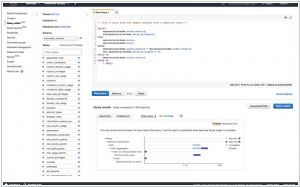Amazon Redshift vs Amazon Web Services
March 19, 2025 | Author: Michael Stromann
12★
Amazon Redshift is a fast, fully managed, petabyte-scale data warehouse service that makes it simple and cost-effective to efficiently analyze all your data using your existing business intelligence tools. You can start small for just $0.25 per hour with no commitments or upfront costs and scale to a petabyte or more for $1,000 per terabyte per year, less than a tenth of most other data warehousing solutions.
26★
IaaS/PaaS cloud platform with over 200 services, including computing, storage, database engines and machine learning. Provides a global network of data centers and pay-as-you-go pricing model.
See also:
Top 10 Big Data platforms
Top 10 Big Data platforms
Amazon Redshift and Amazon Web Services are, in many ways, like two intergalactic entities floating around the vast, nebulous cosmos of cloud computing. They both owe their existence to the mighty Amazon, which, in turn, seems to be on a mission to own every conceivable byte of digital space. They are vast, scalable and occasionally bewildering to the uninitiated, offering promises of security, compliance and seamless integration with other cosmic forces (or, in this case, AWS services). Fundamentally, they exist to handle data, process information and make sure nobody has to store their spreadsheets on a USB stick ever again.
Amazon Redshift, born in the year 2012 (which seems both recent and ancient, depending on your perspective), is a creature designed to crunch vast amounts of data with the enthusiasm of a caffeinated mathematician. It loves complex queries, vast data lakes and the soothing hum of business intelligence dashboards. It is, in short, a data warehouse with ambition, designed for analysts, enterprises and anyone who enjoys talking about "big data" in meetings while nodding sagely. Its spiritual homeland is the United States, but, much like all things cloud, it exists simultaneously everywhere and nowhere at once.
Amazon Web Services, on the other hand, is the grand cosmic overlord of cloud computing, having graced the universe with its presence since 2006. Unlike Redshift, which has a particular fondness for analytics, AWS is an everything machine—compute, storage, machine learning, networking, web hosting and probably something involving artificial intelligence that will one day ask awkward questions about human emotions. It caters to everyone, from tiny startups running on enthusiasm and caffeine to gigantic corporations and governments that would rather not build their own data centers. Originating in the U.S. (like so many things involving ambitious technological expansion), it now stretches its digital tendrils across the planet, quietly powering more of the internet than anyone is entirely comfortable acknowledging.
See also: Top 10 Big Data platforms
Amazon Redshift, born in the year 2012 (which seems both recent and ancient, depending on your perspective), is a creature designed to crunch vast amounts of data with the enthusiasm of a caffeinated mathematician. It loves complex queries, vast data lakes and the soothing hum of business intelligence dashboards. It is, in short, a data warehouse with ambition, designed for analysts, enterprises and anyone who enjoys talking about "big data" in meetings while nodding sagely. Its spiritual homeland is the United States, but, much like all things cloud, it exists simultaneously everywhere and nowhere at once.
Amazon Web Services, on the other hand, is the grand cosmic overlord of cloud computing, having graced the universe with its presence since 2006. Unlike Redshift, which has a particular fondness for analytics, AWS is an everything machine—compute, storage, machine learning, networking, web hosting and probably something involving artificial intelligence that will one day ask awkward questions about human emotions. It caters to everyone, from tiny startups running on enthusiasm and caffeine to gigantic corporations and governments that would rather not build their own data centers. Originating in the U.S. (like so many things involving ambitious technological expansion), it now stretches its digital tendrils across the planet, quietly powering more of the internet than anyone is entirely comfortable acknowledging.
See also: Top 10 Big Data platforms





